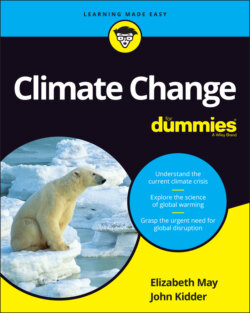Читать книгу Climate Change For Dummies - Elizabeth May - Страница 83
From Fossils to Fuel — How Fossil Fuels Came to Be
ОглавлениеA lot of people know that fossil fuels pollute and produce carbon, but they don’t understand why. To understand that, you need to know where fossil fuels, such as coal, oil, and natural gas, come from. They’re literally derived from fossils of past living matter.
Talk about fossils, and the first things that may come to mind are dinosaurs. But when it comes to the fossils in fossil fuels, they’re actually fossils from before the time of the dinosaurs — starting off as decomposing plant material (not decomposing dinosaurs).
Many of these plants grew in swamps that used to cover even the northernmost parts of the globe 300 to 400 million years ago. Usually, plants and trees rot away into the soil, but swamps don’t have enough air (it’s what scientists call an anaerobic environment) for the usual decomposition process to happen. Instead, over time, these dead plants and trees sank to the bottom of the swamps where they eventually turned into peat. The peat was buried and compressed under layers of sediments such as sand and silt. As these sediments turned into rock, more pressure was piled on the peat below it. The moisture was squeezed out of the peat like water squeezed out of a sponge, turning the peat to fossil fuels. So, millions of years later, fossil fuels are typically found deep underground.
Similar fossil fuels are also found under the ocean, where sea plants and old shells were buried and pressed down under the ocean sediment. See Figure 4-1 to get an idea of what this process looked like.
Not all plant matter in those ancient swamps and in the oceans turned into fossil fuels. The process needed the right conditions, such as enough pressure and the correct bacteria. Although many of these plants were very different from anything known about today, they sucked up carbon dioxide from the atmosphere and gave off oxygen, like all plants still do.
When fossil fuels are burned for energy, those fuels release their carbon, in the form of carbon dioxide and other gases that these ancient plants stored. (For more on why releasing carbon dioxide into the atmosphere is problematic, refer to Chapter 2.)
GHGs are released not only when these fuels are burned, but also when they’re retrieved from the Earth. Extracting the fuels and processing them into their final forms requires fossil fuels, and thus produces carbon dioxide. The oil has to be taken out of the Earth, transported to a refinery, processed into a usable form, and transported to its final destination. Because traditional sources of oil have begun to dry up, industry has turned to sources such as Alberta, Canada’s oil sands, which require even more energy to yield usable fuel. (See the sidebar “How much oil is left” for more about the possible end of oil and the sidebar “Athabasca tar sands: A sticky situation” for information about the tar sands.)
© John Wiley & Sons, Inc.
FIGURE 4-1: How fossil fuel is created.
Fossil fuels give a one-time-only burst of energy. Take them out of the ground and burn them, and that’s it. That’s why they’re called nonrenewable. The supply of fossil fuels is limited, and after people use them up, civilization will have to wait millions of years before any more exist. That’s why, no matter what, civilization will have to rely on a diversity of fuel sources to produce energy in the future. We talk about alternative energy sources in Chapter 13.
